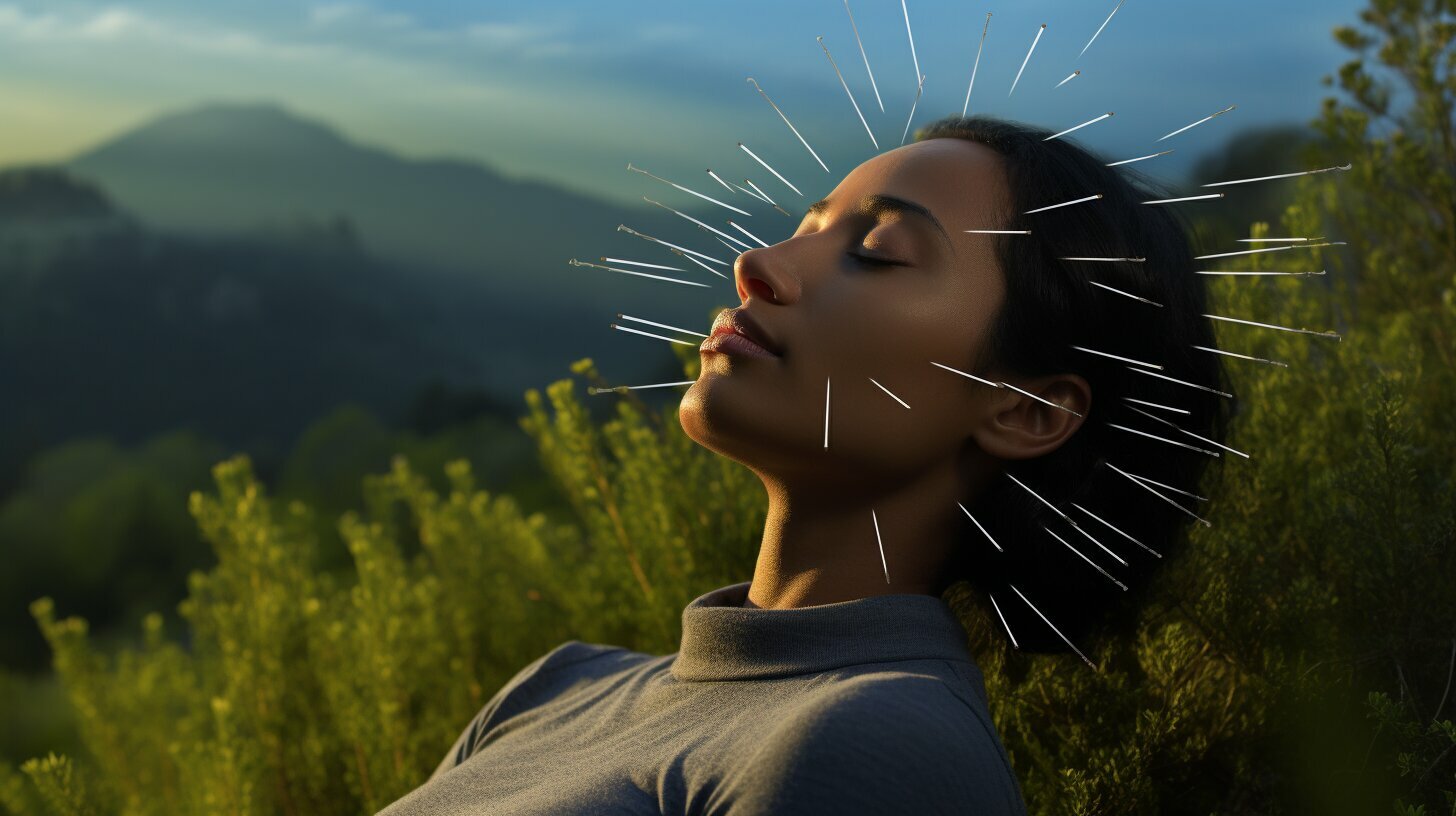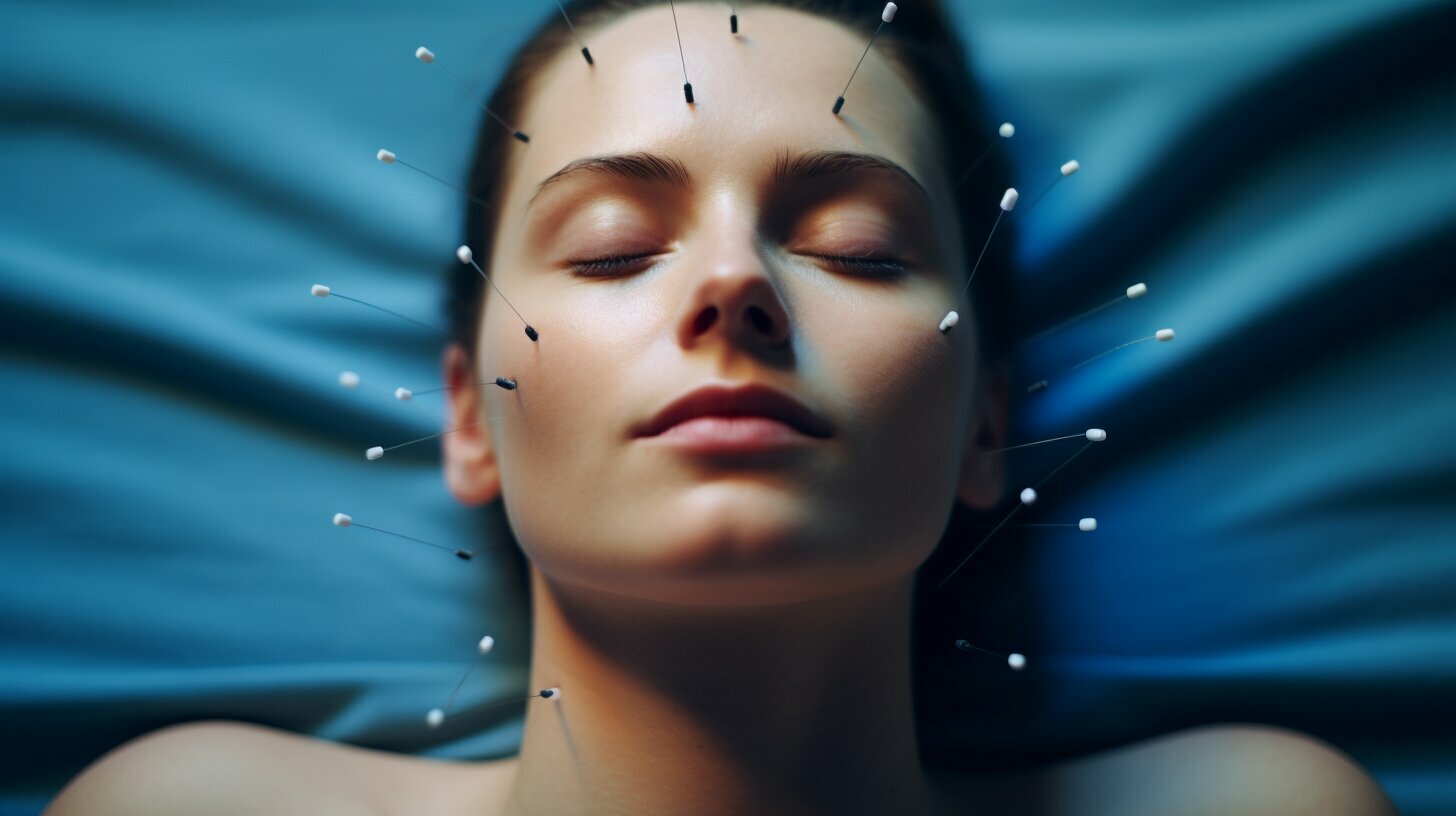
Welcome to my guide on understanding how acupuncture works scientifically. Acupuncture, rooted in traditional Chinese medicine, has gained popularity worldwide as a holistic approach to healing and wellness. But how does it work from a scientific standpoint? In this article, we will explore the mechanism of action behind acupuncture, delve into the scientific research supporting its efficacy, and discuss its potential as a treatment for various conditions.

Key Takeaways:
- Acupuncture is a system of medical treatment based on the principles of traditional Chinese medicine.
- Scientifically, acupuncture works by stimulating sensory nerves, releasing neurotransmitters, and modulating pain signals.
- Research has shown that acupuncture can have various physiological effects, such as reducing inflammation, increasing blood flow, and stimulating the release of endorphins.
- Acupuncture influences physiological changes in the body through the activation of endogenous opioids, modulation of neural pathways, and release of neurotransmitters.
- Acupuncture is widely used for pain management and has been found to be effective in alleviating chronic pain conditions.
The Physiology and Mode of Action of Acupuncture
Acupuncture is a therapeutic technique that has been used for centuries in traditional Chinese medicine. While its effectiveness has been well-documented through anecdotal evidence, more recent scientific research has shed light on the physiological changes that occur during acupuncture treatments.
One of the key mechanisms behind acupuncture’s therapeutic effects is its ability to stimulate the release of endogenous opioids, such as endorphins. These naturally occurring chemicals act as pain relievers and can help alleviate discomfort during treatments. Additionally, acupuncture has been found to modulate the transmission of pain signals in the central nervous system, effectively blocking pain messages from reaching the brain.
But acupuncture’s benefits extend beyond pain management. Studies have shown that acupuncture can also influence biochemical responses in the body. For example, it has been found to stimulate the release of neurotransmitters like serotonin and dopamine, which play crucial roles in mood regulation and pain modulation. Additionally, acupuncture has been shown to have anti-inflammatory effects and can promote the release of immunomodulatory factors, further contributing to its therapeutic effects.
In summary, acupuncture works by stimulating the body’s natural healing mechanisms through physiological changes. These changes include the release of endogenous opioids, modulation of pain signals in the central nervous system, and the stimulation of neurotransmitters and immunomodulatory factors. The scientific evidence behind acupuncture provides a solid foundation for its efficacy as a complementary therapy for a variety of conditions.
Acupuncture as a Treatment for Various Conditions
Acupuncture has emerged as a popular alternative therapy for the management of various conditions, especially when it comes to pain modulation. Scientific research has shown that acupuncture can effectively alleviate chronic pain, including back pain, knee pain, and headaches. It has also been found to be beneficial in the treatment of conditions such as fibromyalgia and osteoarthritis.
One of the reasons acupuncture is effective in pain relief is its ability to modulate pain perception. By stimulating specific acupuncture points, the release of endogenous opioids, or natural pain-relieving substances, is triggered. This mechanism helps to inhibit pain signals and promote relaxation, leading to a reduction in pain intensity.
Understanding acupuncture scientifically allows us to appreciate its therapeutic potential. Research has shown that acupuncture not only influences the release of endogenous opioids but also affects neural pathways involved in pain perception. By stimulating these pathways, acupuncture helps to modulate the transmission of pain signals in the central nervous system, further contributing to its pain-relieving effects.

Table: Conditions Treated with Acupuncture
| Condition | Scientific Evidence |
|---|---|
| Chronic Back Pain | Several studies have shown significant pain reduction and improvement in functional outcomes in patients with chronic back pain who underwent acupuncture treatment. |
| Osteoarthritis | Acupuncture has been found to alleviate pain and improve joint function in individuals with osteoarthritis, particularly in the knee. |
| Migraines | Research suggests that acupuncture can reduce the frequency, duration, and severity of migraines, offering a valuable alternative or adjunctive treatment option. |
| Fibromyalgia | Acupuncture has been shown to reduce pain and improve overall quality of life in individuals with fibromyalgia. |
By recognizing and understanding acupuncture’s scientific basis, we can confidently embrace it as a treatment option for various conditions, especially when it comes to pain management. Its ability to modulate pain perception, stimulate the release of endogenous opioids, and influence neural pathways makes it an attractive alternative or adjunctive therapy. As always, it is important to consult with a qualified acupuncture practitioner and discuss its potential benefits in relation to your specific condition.
Safety and Considerations of Acupuncture
When it comes to acupuncture, safety is a top priority. It is essential to choose a qualified and licensed practitioner to ensure the highest standards of care. Acupuncture is generally considered safe when performed by a skilled professional who follows strict hygiene practices. The use of sterile needles minimizes the risk of infection, and practitioners adhere to proper protocols to maintain a clean and safe environment.
However, it is important to be aware of certain contraindications and precautions associated with acupuncture. Individuals with bleeding disorders or those taking blood thinners may have an increased risk of bleeding during acupuncture sessions. It is recommended to inform your acupuncturist about any medications or health conditions you have to ensure safe treatment.
Additionally, electrical stimulation used in certain acupuncture techniques may interfere with pacemakers or other electrical devices. If you have any electronic implants or devices, it is crucial to discuss this with your practitioner before undergoing acupuncture.
Pregnant women should also exercise caution when considering acupuncture. While acupuncture can be beneficial during pregnancy, certain acupuncture points may stimulate labor and should be avoided without consultation with a healthcare provider. It is always advisable to inform your doctor or midwife about your interest in acupuncture and seek their guidance.
Table: Contraindications to Acupuncture
| Contraindications | Precautions |
|---|---|
| Bleeding disorders | Inform your acupuncturist about any medications or health conditions |
| Use of blood thinners | Discuss your medical history with your acupuncturist |
| Presence of electronic implants or devices | Notify your acupuncturist if you have any electronic implants or devices |
| Pregnancy | Consult your healthcare provider before undergoing acupuncture |
Choosing a licensed and experienced acupuncture practitioner, discussing any health concerns or medications, and following the recommendations for safety and precautions will help ensure a safe and beneficial acupuncture experience.
The Process of Acupuncture Treatment
Acupuncture treatment involves the insertion of thin needles into specific points on the body. The needles used in acupuncture are typically stainless steel and range in length from 10 to 100 mm. These needles are usually single-use or properly sterilized between sessions to minimize the risk of infection. The number of needles inserted and the duration of the treatment session may vary depending on the individual and the condition being treated.
During acupuncture treatment, the practitioner carefully selects the acupuncture points based on the patient’s diagnosis and desired outcomes. The specific points chosen may differ from person to person and can be located anywhere on the body, including the limbs, back, abdomen, and head.
When the needles are inserted, they are typically manipulated by hand or through electrical stimulation to elicit specific therapeutic effects. The sensation experienced during acupuncture can vary from person to person, but it is generally described as a mild tingling or dull ache. The level of discomfort is usually minimal and well-tolerated by most individuals.
Benefits of Acupuncture Equipment
Acupuncture equipment plays a crucial role in ensuring the efficacy and safety of the treatment. The use of sterile, single-use needles and adherence to proper hygiene practices minimize the risk of infection. Additionally, the cleanliness and sterility of acupuncture equipment help maintain a high standard of care for patients.
Furthermore, advancements in acupuncture equipment have led to the development of specialized tools for different techniques and treatment modalities. For example, electroacupuncture devices provide electrical stimulation to enhance the therapeutic effects of acupuncture. Other equipment, such as laser acupuncture devices and acupressure tools, offer alternative methods for stimulating acupuncture points.
In summary, the process of acupuncture treatment involves the precise insertion of needles into specific points on the body. The use of acupuncture equipment, such as sterile needles and specialized tools, ensures the safety and effectiveness of the treatment. The needles are manipulated to elicit therapeutic effects, and the sensation experienced during acupuncture is generally mild. Overall, acupuncture treatment offers a holistic approach to promoting health and well-being.
| Pros of Acupuncture Treatment | Cons of Acupuncture Treatment |
|---|---|
|
|
References:
- Weir, R. F., & Snowdon, S. (2019). Acupuncture therapy.
- National Center for Complementary and Integrative Health. (2021). Acupuncture: In-depth.
Choosing an Acupuncture Practitioner
When it comes to acupuncture, finding the right practitioner is crucial for a safe and effective treatment. So, how do you choose the right acupuncture practitioner for your needs? Here are some key factors to consider:
First and foremost, it’s important to seek recommendations from trusted individuals who have had positive experiences with acupuncture. Their insights can provide valuable guidance in your search for a practitioner.
Secondly, do some research on the training and credentials of potential acupuncture practitioners. In the United States, acupuncturists may be certified by the National Certification Commission for Acupuncture and Oriental Medicine. Check if the practitioner you are considering has the necessary qualifications and meets the required standards.
Furthermore, consider interviewing the practitioner before committing to treatment. This allows you to inquire about the treatment process, the practitioner’s experience with your specific condition, the expected effectiveness, and the associated costs. Be sure to ask about insurance coverage for acupuncture as well.
Lastly, it’s crucial to keep your primary healthcare provider in the loop. Inform your doctor about your interest in acupuncture, as they can provide valuable advice and ensure coordinated care between treatments.
FAQ
How does acupuncture work scientifically?
Acupuncture is believed to work by stimulating sensory nerves, releasing neurotransmitters, and modulating pain signals. It can also have physiological effects such as reducing inflammation and increasing blood flow.
What is the scientific evidence behind acupuncture?
Research has shown that acupuncture can activate the release of endogenous opioids, stimulate the release of neurotransmitters, and have anti-inflammatory effects. These physiological changes contribute to the therapeutic effects of acupuncture.
What conditions can acupuncture treat?
Acupuncture has been shown to be effective in alleviating chronic pain, including back pain, knee pain, and headaches. It can also be beneficial for conditions like fibromyalgia and osteoarthritis.
Is acupuncture safe?
Acupuncture is generally considered safe when performed by a qualified practitioner. However, there are certain contraindications and precautions to consider, such as bleeding disorders and electrical devices like pacemakers.
What is the process of acupuncture treatment?
Acupuncture involves the insertion of thin needles into specific points on the body. The number of needles and duration of the session may vary. The treatment is usually minimally uncomfortable and performed in a calm environment.
How do I choose an acupuncture practitioner?
It is important to choose a qualified and experienced practitioner. Recommendations, research on their training and credentials, and interviewing the practitioner are essential. Informing your doctor is also advisable.


